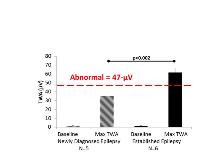Dynamic Tracking of Cardiac Electrical Instability in Patients With Newly Diagnosed or Chronic Epilepsy Using Ambulatory ECG Monitoring and High-Resolution ECG Patches
Abstract number :
1.120
Submission category :
2. Translational Research / 2E. Other
Year :
2018
Submission ID :
498988
Source :
www.aesnet.org
Presentation date :
12/1/2018 6:00:00 PM
Published date :
Nov 5, 2018, 18:00 PM
Authors :
Trudy Pang, Beth Israel Deaconess Medical Center, Harvard Medical School; Bruce Nearing, Beth Israel Deaconess Medical Center, Harvard Medical School; Kaarkuzhali Babu Krishnamurthy, St. Elizabeth’s Medical Center; Bryan Olin, LivaNova; Steven Schac
Rationale: Identification of individuals with epilepsy who are at risk for life-threatening cardiac arrhythmias remains a major challenge. The Amsterdam Resuscitation Study (ARREST) and Oregon Sudden Unexpected Death Study revealed that risk of death due to sudden cardiac arrest is 3-fold greater in patients with epilepsy than in the general population. T-wave alternans (TWA) is an established marker of sudden cardiac death risk. The study had two objectives: (1) to examine whether TWA is elevated in patients with chronic over newly diagnosed epilepsy, and (2) to investigate whether TWA can be tracked using ECG patches, which extend the monitoring period from 1 to 2 days with traditional Holter recorders to 2 weeks. Methods: Eleven patients (newly diagnosed epilepsy, n=5; chronic epilepsy, n=6) were each monitored either with a 24-hour 12-lead digital Holter recorder alone (GE Healthcare, Milwaukee WI) or simultaneously with Holter and 14-day “Zio XT” Monitor (iRhythm Technologies, San Francisco CA). Chronic epilepsy patients maintained their prescribed antiepileptic drugs. TWA was assessed using FDA-cleared modified moving average analysis. Baseline TWA was monitored during a quiescent period. Results: Maximum TWA levels in patients with newly diagnosed epilepsy were significantly lower than in patients with chronic epilepsy (35±1.3 vs 62±5.4 µV, p<0.002) (Figure 1) and not different from healthy control adults (typically, 30 µV (range: 26–37)). Of the 6 patients with chronic epilepsy, 5 exceeded the =47-µV TWA cutpoint across the 2-week monitoring period, indicating a 3- to 4-fold increased risk for cardiovascular mortality and sudden cardiac death over the general population. Patients with chronic epilepsy exhibited elevated maximum TWA levels equivalently on Holter and ECG patch recordings [61.8±5.4 µV (Holter) vs. 60.3±5.0 µV (Patch), p=0.39] with a high correlation (r2=0.99, p<0.01) across 24 hours (Figure 2 upper panel). In one patient with established epilepsy, ventricular tachycardia occurred on the 4th day of the ECG patch recording following an increase in TWA (Figure 2, lower panel). This arrhythmia would not have been detected by the briefer 24-hour standard Holter monitoring period. No seizures occurred during the monitoring period. Conclusions: Patients with newly diagnosed epilepsy exhibit lower levels of TWA than those with chronic epilepsy. ECG patches have equivalent accuracy to Holter monitoring for TWA but greater ease of use, thereby permitting longer term ECG sampling and identification of cardiac electrical instability in patients with chronic epilepsy. Funding: LivaNova PLCiRhythm

.tmb-.jpg?Culture=en&sfvrsn=45c5d9d9_0)